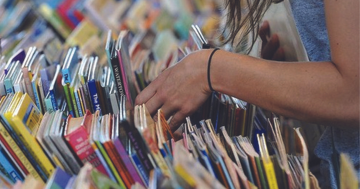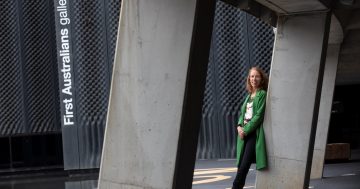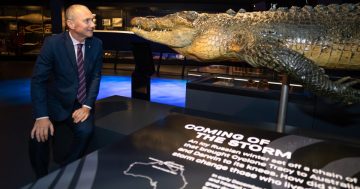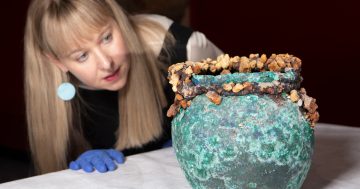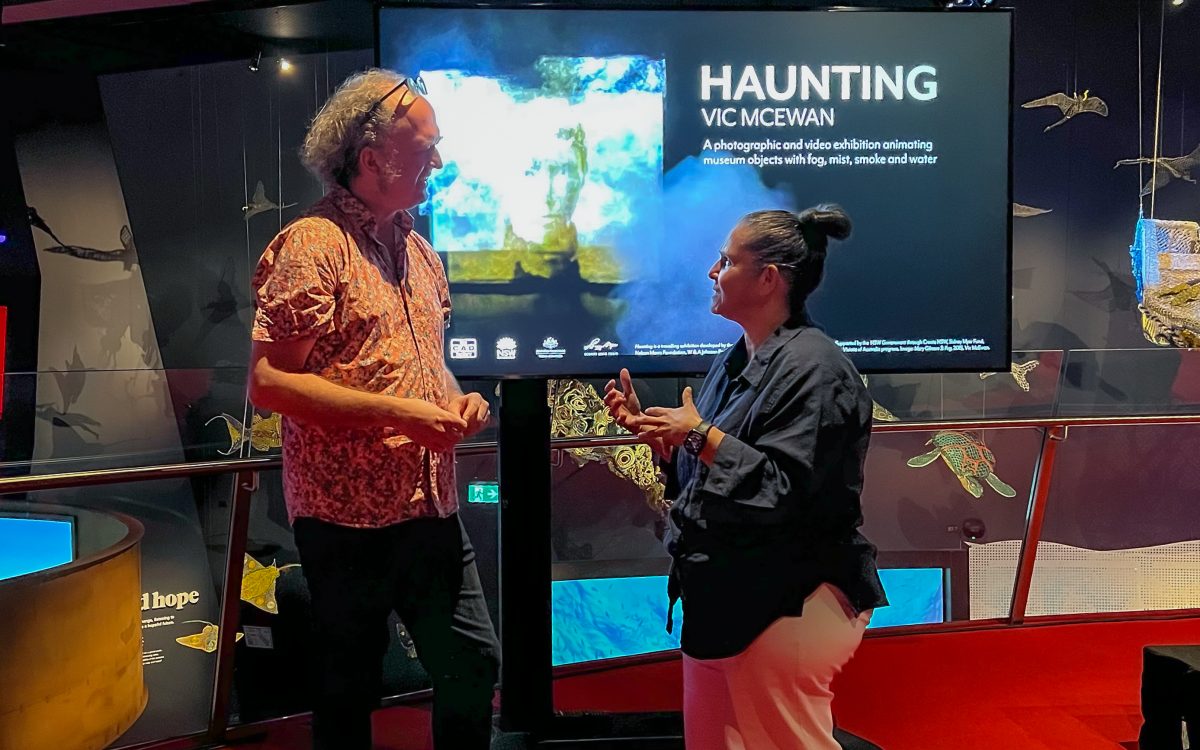
Artist Vic McEwan with Ngunnawal elder Jude Barlow at the opening of Haunting at the National Museum of Australia on Thursday. Photo: Martin Prosser.
Our connection to the land, although almost severed by invasion, colonisation and subjugation, will never waiver, says Ngunnawal elder Jude Barlow.
In her Welcome to Country on Thursday, at the opening of the National Museum of Australia’s (NMA) latest exhibition, Haunting, Aunty Jude said she was also proud to know who she was and her totem, the bogong moth.
“It’s a symbol of hope, strength and resilience,” she said.
When “this gentle little creature” was feared lost after the 2020 bushfires and COVID, Aunty Jude said she had always kept the faith. Somehow, the moth had managed to survive – and repopulate her colony.
“So for me, she is the symbol of Aboriginal Australia,” she said.
Haunting, created by artist Vic McEwan and NMA curator Dr George Main, exemplified this connection to land, she told guests at the official opening.
In something of a departure for the cultural institution and collector of our history, the contemporary exhibition projects a series of images of NMA collection items onto the dark water of the Murrumbidgee River into fog, mist and smoke. All the images depict the history of land use and farming in the Murray-Darling Basin.
For McEwan, who was the NMA’s artist-in-residence in 2015, it’s all about bringing these NMA objects out from behind the glass and “reanimate them with fog, mist, smoke and water”.
Some parts of the NMA collection captured digitally for Haunting might seem like ordinary items, flashes from times gone by. But in this exhibition, they mean so much more. They tell our stories.
The items include seed-grinding stones from the Murrumbidgee near Narrandera, used by Wiradjuri people around 1820 to make flour. There’s also an image of a vast stack of wheat bags at Temora, waiting for transport to Sydney circa 1920, one of the railway bridges across the Murrumbidgee at Wagga Wagga, photographed in the late 1890s, and prolific Australian writer and journalist Mary Gilmore’s typewriter – on the Murrumbidgee.
McEwan, who is the co-founder and artistic director of the CAD Factory, based in Narrandera, described his time with the Canberra museum as an “incredible opportunity”.
To be able to use images of rare NMA collection items “by layering them back into the landscape using light, projection and natural elements, while re-photographing them, we managed to create a series of abstract images which appear as though they were painted with light into the landscape”.
”What I want to do with projects like this is to keep storytelling alive,” he said.
Stories about artists collaborating with other creative souls raise few eyebrows; but artists collaborating with, say, a river, especially one with the strength and power of the Murrumbidgee, maybe at least one brow. But that’s what McEwan and Main did for Haunting.
On the coldest of nights, when the fog rolled in, they projected images of selected NMA objects, photographs and maps across the Murrumbidgee onto the fog and campfire smoke drifting across the dark water.
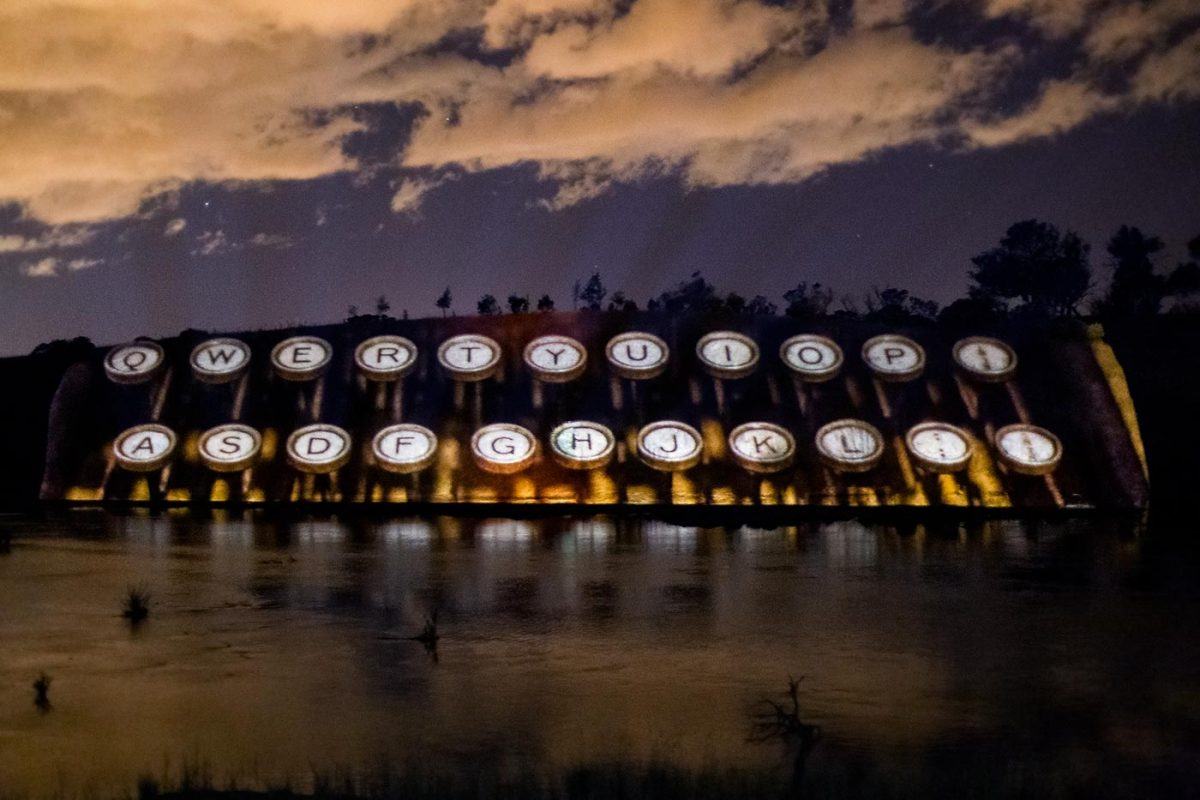
Mary Gilmore’s typewriter on the Murrumbidgee River. Photo: Haunting exhibition, National Museum of Australia.
McEwan said it was not the easiest of tasks to get the fog to come in on cue. Some nights it was just a matter of sitting and waiting in the cold or, in their excitement that fog had started to roll in, driving a little too fast down to the river and into a wombat hole.
The river brought the imagery alive, good history and bad. For thousands of years, First Nations Australians tended the river and its surrounds, banking on it for their survival and that of their animals. That was until the early 1800s with the arrival of colonisation.
“Haunting honours the Murrumbidgee and its communities of people … it reveals how history – like the river – flows through the land and our lives,” McEwan said.
NMA director Dr Mathew Trinca said he hoped Haunting would encourage people to see the NMA’s collection in new ways.
“Haunting is a fascinating body of work that encompasses photography, video and text,” he said. “Demonstrating how objects and stories can be brought to life, this exhibition provokes various interpretations of the past and its ever-unfolding consequences in the present.”
Haunting is at the National Museum of Australia, Canberra, until 30 April. It is open daily, with free admission.











